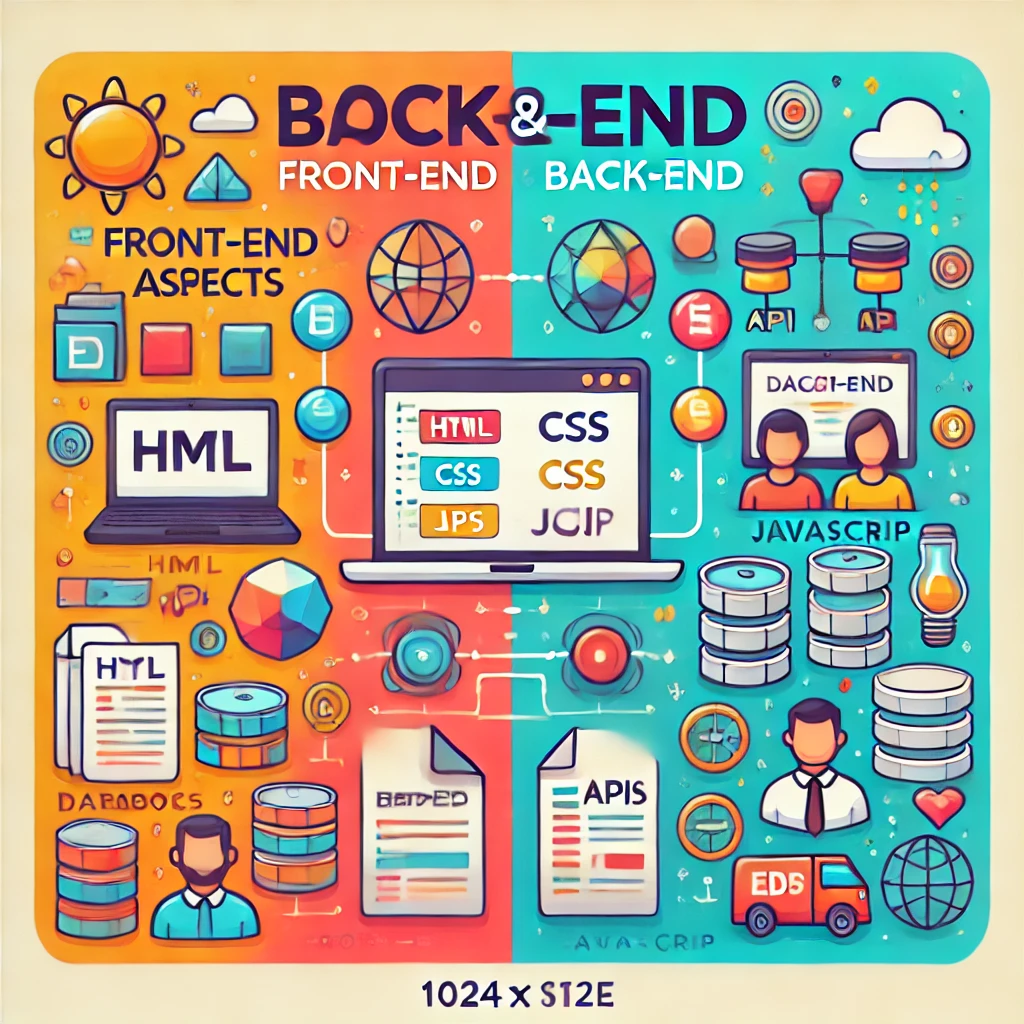Difference Between Front-End and Back-End Development for Beginners

Web development consists of two essential parts: front-end and back-end development. Understanding the roles and responsibilities of each can help beginners decide which path to pursue. In this guide, we’ll break down the key differences, skills needed, and tools used in front-end and back-end development.
Introduction to Front-End and Back-End Development
Every website and web application has two sides: the front-end (client-side) and the back-end (server-side). Front-end development is focused on what users see and interact with, while back-end development powers the functionality behind the scenes. Knowing the differences between these two areas is crucial for anyone starting a career in web development.
What is Front-End Development?
Front-end development involves creating the parts of a website that users interact with directly, such as the layout, design, and interactive elements. The goal is to make a website visually appealing, responsive, and user-friendly.
Key Skills and Technologies for Front-End Development
- HTML: The foundation of a webpage, HTML structures the content and elements on a page.
- CSS: CSS adds styling to HTML elements, allowing developers to create visually appealing designs.
- JavaScript: Adds interactivity to the page, enabling dynamic features like animations, pop-ups, and responsive menus.
Popular front-end frameworks and libraries include React, Vue.js, and Angular. These tools streamline the development process and make it easier to build complex user interfaces.
What is Back-End Development?
Back-end development refers to the server side of a website. It involves working with databases, servers, and APIs to manage data and ensure smooth communication between the front-end and the server. Back-end developers handle the core logic that makes a website function correctly.
Key Skills and Technologies for Back-End Development
- Server-Side Languages: Common languages include Python, Ruby, Java, PHP, and JavaScript (Node.js) for building the server logic.
- Databases: Databases like MySQL, MongoDB, and PostgreSQL are used to store and retrieve data.
- APIs: APIs (Application Programming Interfaces) facilitate communication between the front-end and back-end, especially in dynamic applications.
Popular back-end frameworks include Django (Python), Express (Node.js), and Laravel (PHP). These frameworks simplify the back-end development process and ensure scalability and security.
What is Front-End Development?
Front-end development, also known as client-side development, focuses on the parts of a website that users interact with directly. Front-end developers work on the layout, design, and interactivity of a site to ensure it looks great and functions smoothly across all devices.
Skills and Technologies for Front-End Development:
- HTML: Defines the structure and content of the web pages.
- CSS: Adds styling to the HTML to make the site visually appealing.
- JavaScript: Adds interactivity and functionality, allowing dynamic content and features.
Popular front-end frameworks and libraries include React, Vue.js, and Angular, which help streamline development and create responsive designs.
What is Back-End Development?
Back-end development, also called server-side development, involves the technical components behind the scenes that power a website. Back-end developers handle the logic, database interactions, and server configurations necessary to deliver data to the front-end efficiently.
Skills and Technologies for Back-End Development:
- Server-Side Languages: Common languages include Python, Java, PHP, and Node.js.
- Databases: Managing data with SQL databases (e.g., MySQL, PostgreSQL) or NoSQL databases (e.g., MongoDB).
- APIs: Creating and maintaining APIs to allow front-end and back-end communication.
Popular back-end frameworks include Django (Python), Express (Node.js), and Laravel (PHP), which help developers build secure, scalable web applications.
Key Differences Between Front-End and Back-End Development
- Focus: Front-end is about user experience and UI design, while back-end is about server-side logic and database management.
- Technologies: Front-end uses HTML, CSS, JavaScript, and frameworks like React and Angular, while back-end uses server-side languages like Python, Java, and PHP, and databases like MySQL, MongoDB, or PostgreSQL.
- Interaction with Users: Front-end directly interacts with users, while back-end deals with data storage, retrieval, and processing that users don’t see.
- Skills Required: Front-end developers need to be good at UI/UX design and scripting languages, while back-end developers focus on databases, servers, and application logic.
Career Paths in Front-End and Back-End Development
Beginners may find it helpful to specialize in either front-end or back-end development. However, both paths offer rewarding opportunities. Here are a few common job roles:
Front-End Developer Roles
- Junior Front-End Developer
- UI/UX Developer
- JavaScript Developer
Back-End Developer Roles
- Junior Back-End Developer
- API Developer
- Database Administrator
If you’re interested in learning both sides, consider becoming a Full-Stack Developer, where you’ll handle both front-end and back-end development tasks.
Conclusion
Understanding the difference between front-end and back-end development is essential for beginners exploring web development careers. Each role plays a crucial part in building a successful website, and choosing one depends on your interests and strengths. Front-end development focuses on user experience, while back-end development powers the server-side operations. Both are in-demand skills with exciting career prospects.
Get In Touch
We’d love to hear from you! Whether you have questions, feedback, or simply want to connect, our team is here to help. Feel free to reach out, and we’ll get back to you as soon as possible.

